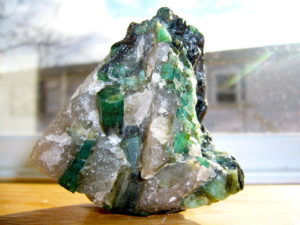4.4.1: Time and Temperature
- Page ID
- 19137
Minerals Crystallizing From a Single Drop of Water
Click on this image to see a video that shows spectacular examples of crystals precipitating from water. It is a time lapse video; the crystallization occurred as the water drops evaporated. Unfortunately, only the first crystals (halite) exist in nature as minerals. Still, the other crystals are quite beautiful.

The most important factors controlling crystal size and perfection are temperature, time, abundance of necessary elements, and the presence or absence of a flux. All work together, but we can make some generalizations. Temperature is important because at high temperatures atoms are very mobile. Crystals can grow quickly; large and well-formed crystals may be the result. Principles of thermodynamics tell us that crystals that form at high temperatures have simpler atomic structures than those that are stable at low temperatures. This is one reason they can be large and well ordered.
Time is important because if a crystal has a long time to grow, it will naturally be larger and better ordered than one that grows quickly. More atoms will migrate to the growing crystal and order themselves in a regular way. This explains why intrusive igneous rocks, which cool slowly underground, are coarser-grained than extrusive igneous rocks of the same compositions. Some extrusive igneous rocks, such as obsidian, cool so quickly that they contain glass.
Whatever the time and temperature, crystals cannot grow large if the necessary elements are not available. In most rocks, a dozen elements or less account for 90% of the composition. Minerals composed of those elements will usually be larger than those composed of rarer elements. But, even if time, temperature, and atoms are right, crystals may not grow large. Diffusion of atoms through solids is slow, and atoms may not migrate easily to spots where crystals are growing. However, if a hydrothermal fluid is present, it can serve as a flux that delivers atoms to sites of crystallization. For example, the YouTube video (link above in Box 4-3) shows crystals growing from a drop of water – the water delivers atoms to sites of crystal growth.

Magmas, too, can act as fluxes. So, hydrothermal and igneous minerals may grow relatively quickly, and even minerals composed of rare elements may grow to be large. This explains why large crystals of unusual composition may form in pegmatites. Pegmatites form from magmas rich in hydrothermal fluids that concentrate exotic elements like beryllium. The photo shows green beryl, one of the most common beryllium minerals, in a pegmatite from Brazil.


